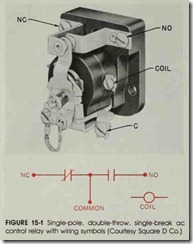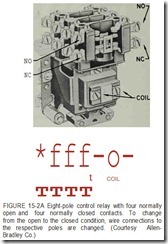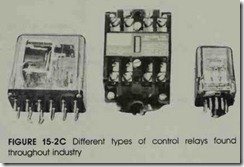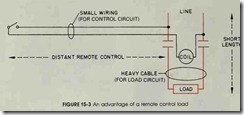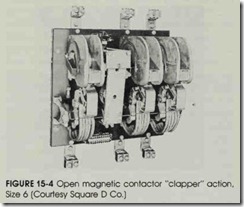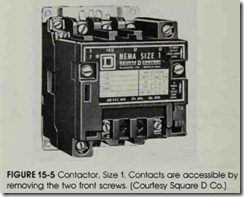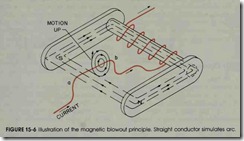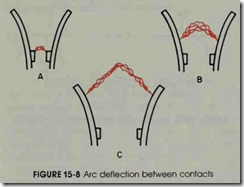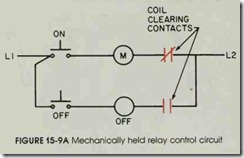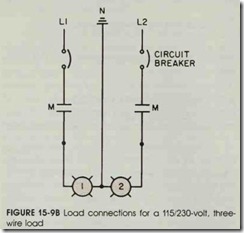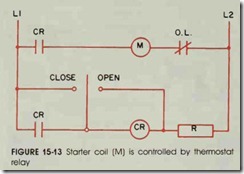OBJECTIVES
After studying this unit, the student will be able to:
• Tell how magnetic relays differ from contactors
• List the principal uses of each magnetic relay and contactor
• Describe the operation of magnetic blowout coils and how they provide arc suppression
• Identify single and double throw contacts; single and double break contacts
• Draw the wiring diagram symbols for contactors and relays
• Describe the operation and use of mechanically held relays
• Draw elementary diagrams of control and load for mechanically held relays and contactors
• Connect wiring for mechanically held relays and contactors
CONTROL RELAYS
Control magnetic relays are used as auxiliary devices to switch control circuits and large motor starter and contactor coils, and to control small loads such as small motors, solenoids, electric heaters, pilot lights, audible signal devices and other relays, figure 15-1.
A magnetically held relay is operated by an electromagnet which opens or closes electrical con tacts when the electromagnet is energized. The position of the contacts changes by spring and gravity action when the electromagnet is de-ener gized.
Relays are generally used to enlarge or am plify the contact capability, or multiply the switching functions of a pilot device by adding more contacts to the circuit, figures 15-2A and B. Most relays are used in control circuits; there fore, their lower ratings (0-15 amperes maximum
to 600 volts) show the reduced current levels at which they operate.
Magnetic relays do not provide motor over load protection. This type of relay ordinarily is used in a two-wire control system (any electrical contact-making device with two wires). Whenever it is desired to use momentary contact pilot de vices, such as push buttons, any available nor mally open contact can be wired as a holding cir cuit in a three-wire system (see the Glossary). The contact arrangement and a description of the mag netic structure of relays was presented in Unit 13, as motor starters. Starters, contactors, and relays are similar in construction and operation but are not identical.
Control relays are available in single-or dou ble-throw arrangements with various combinations of normally open (NO) and normally closed (NC) contact circuits. While there are some single-break contacts used in industrial relays, most of the relays used in machine tool control have double break contacts. The comparison can be seen in fig ures 15-1 and 15-2A. Looking at the relay contacts in figure 15-2A, note the upper contact being open at two points, making it a double break. The lower contact is normally closed with a circuit from the left-hand terminal screw, through the double-break contact to the right-hand terminal screw. One set of normally closed and one of nor mally open contacts represents this description with the wiring symbols. This is also a single throw contact because it has no common connec tion between the normally open and normally closed contacts, such as can be seen in figure 15-
1. The common terminal between the normally closed and normally open contacts makes this a “single-pole, double-throw” relay.
It may be of particular interest to an electri cian to know about changing contacts that are nor mally open to normally closed, or the other way around , NC to NO. Most machine tool relays have some means to make this change. It ranges from a simple flip-over contact to removing the contacts and relocating with spring location changes.
Also, by overlapping contacts in this case, one contact can be arranged to operate at a differ ent time relative to another contact on the same relay. For example, the normally open contact closes before the normally closed contact opens.
Relays differ in voltage ratings, number of contacts, contact rearrangement, physical size, and in attachments to provide accessory functions such as mechanical latching and timing. (These are discussed later in this unit.)
In using a relay for a particular application, one of the first steps should be to determine the control (coil) voltage at which the relay will oper ate. The necessary contact rating must be made, as well as the number of contacts and other char acteristics needed. Because of the variety of styles of relays available, it is possible to select the cor rect relay for almost any application.
Relays are used more often to open and close control circuits than to operate power circuits.
Typical applications include the control of motor starter and contactor coils, the switching of sole noids, and the control of other relays. A relay is a small but vital switching component of many com plex control systems. Low-voltage relay systems are used extensively in switching residential and commercial lighting circuits and individual light ing fixtures.
While control relays from various manufac turers differ in appearance and construction, they are interchangeable in control wiring systems if their specifications are matched to the require ments of the system. Different types of relays are shown in figure IS-2C .
CONTACTORS
Magnetic contactors are electromagnetically operated switches that provide a safe and conve nient means for connecting and interrupting branch circuits. The principal difference between a contactor and a motor starter is that the contac tor does not contain overload relays. Contactors are used in combination with pilot control devices to switch lighting and heating loads and to control ac motors in those cases where overload protection is provided separately. The larger contact or sizes are used to provide remote control of relatively high-current circuits where it is too expensive to run the power leads to the remote controlling lo cation, figure IS-3. This flexibility is one of the main advantages of electromagnetic control over manual control. Pilot devices such as push but tons, float switches, pressure switches , limit switches, and thermostats are provided to operate the contactors.
Magnetic Blowout
The contactors shown in figures IS-4 and IS S operate on alternating current. Heavy-dut y con tact arc-chutes are provided on most of these larger contactors, figure lS-4. The chutes contain heavy copper coils called blowout coils , mounted above the contacts in series with the load to pro vide better arc suppression. These magnetic blow out coils help to extinguish an electric arc at con tacts opening under alternating-current and direct current loads. These arcs may be similar in inten sity to the electric arc welding process. An arc quenching device is used to assure longer contact life. Since the hot arc is transferred from th e con tact tips very rapidly, the contacts remain cool and, thereby, last longer .
Contactor and motor starter contacts that fre quently break heavy currents are subject to a de structive burning effect if the arc is not quickly extinguished. The arc that is formed when the contacts open can be lengthened, and extinguished by motor action if it is in a magnetic field. This magnetic field is provided by the magnetic blow out coil. Since the coil of the magnet is usually in series with the line, the field strength and extin guishing action are in proportion to the size of the arc.
Figure 15-6 is a sketch of a blowout magnet with a straight conductor (ab) located in the field and in series with the magnet. This figure can rep resent either de polarity or instantaneous alternat ing current. With alternating current, the blowout coil magnetic field and the conductor (arc) mag netic field will reverse simultaneously. According to Fleming’s left-hand rule, motor action will tend to force the conductor in an upward direction. The application of the right-hand rule for a single conductor shows that the magnetic field around the conductor aids the main field on the bottom and opposes it on the top, thus producing an up ward force on the conductor.
Figure 15-7 shows a section of figure 15-6 with the wire (ab) replaced by a set of contacts. The contacts have started to open and there is an arc between them.
Figure 15-8 shows what happens because of the magnetic action. Part A shows the beginning deflection of the arc because of the effect of the motor action. Part B shows that the contacts are separated more than in A and the arc is beginning to climb up the horns because of the motor action and the effect of increased temperature. Part C of figure 15-8 shows the arc near the tips of the horns. At this point, the arc is so lengthened that it will be extinguished.
The function of the blowout magnet is to move the arc upward at the same time that the contacts are opening. As a result, the arc is length ened at a faster rate than would normally occur because of the opening of the contacts alone. It is evident that the shorter the time the arc is allowed to exist, the less damage it will do to the contacts.
Most arc quenching action is based upon this prin ciple.
AC MECHANICALLY HELD CONTACTORS AND RELAYS
A mechanically held relay, or contactor, is operated by electromagnets but the electromagnets are automatically disconnected by contacts within the relay. Accordingly, these relays arc mechani cally held in position and no current flows through the operating coils of these electromagnets after switching. It is apparent, therefore, that ncar continuous operation of multiple units of substantial size will lower the electrical energy requirements. Also, the magnetically held relay, in comparison, will change contact position upon loss of voltage to the electromagnet, whereas the mechanically held relay will respond only to the action of the control device.
Sequence of Operation
Referring to figure 15-9A, when the “on” push button is pressed momentarily, current flows from L1 through the on push-button contact en ergizing the M coil through the now closed clear ing contact, to L2. The relay now closes and latches mechanically. At the same time it closes Mcontacts (in figure 15-9B), lighting a bank of lamps when the circuit breaker is closed. To un latch the relay, thereby turning the lamps off, the off button is pressed momentarily, unlatching the relay and opening contacts M, turning off the lamps. Most operating coils are not designed for continuous duty. Therefore, they are disconnected automatically by contacts to prevent an accidental coil burnout. These coil clearing contacts change position alternately with a change in contactor latching position.
Figure 15-10 shows a three-phase power load application using one main contactor to disconnect the distribution panel. Selective single, or three phase, branch circuits may be switched indepen dently by other mechanically held contactors or relays.
These mechanically held contactors and re lays are electromechanical devices, figure 15-11. They provide a safe and convenient means of switching circuits where quiet operation, energy ef ficiency, and continuity of circuit connection are re quirements of the installation. For example, cir cuit continuity during power failures is often important in automatic processing equipment, where a sequence of operations must continue from the point of interruption after power is resumed-rather than return to the beginning of the sequence. Quiet operation of contactors and relays is required in many control systems used in hospitals, schools, and office buildings. Mechanically held contactors and relays are gen erally used in locations where the slight hum, characteristic of alternating-current magnetic de vices, is objectionable.
In addition, mechanically held relays are of ten used in machine tool control circuits. These relays can be latched and unlatched through the operation of limit switches, timing relays, starter interlocks, timeclocks, photoelectric cells, other control relays, or push buttons. Generally, me chanically held relays are available in 10- and IS ampere sizes; mechanically held contactors are also available in sizes ranging from 30 amperes to 1200 amperes.
THERMOSTAT RELAY
Thermostat-type relays, figure 15-12, arc used with three-wire, gauge-type thermostat con trols or other pilot controls having a slowly mov ing element which makes a contact for both the closed and open positions of the relay. The con tacts of a thermostat control device usually cannot handle the current to a starter coil; therefore, a thermostat relay must be used between the ther
L2 mostat control and the starter, figure 15-13.
When the moving element of the thermostat control touches the closed contact, the relay closes and is held in this position by a maintaining con tact. When the moving element touches the open
contact, the current flow bypasses the operating coil through a small resistor and causes the relay to open. The resistor is usually built into the relay and serves to prevent a short circuit.
The thermostat contacts must not overlap or be adjusted too closely to one another as this may result in the resistance unit being burned out. It is also advisable to compare the inrush current of the relay with the current rating of the thermostat.
REVIEW QUESTIONS
1. What are control relays?
2. What are typical uses for control relays?
3. Why are contactors described as both control pilot devices and large magnetic switches controlled by pilot devices?
4. What is the principal difference between a contactor and a motor starter?
5. What causes the arc to move upward in a blowout magnet?
6. Why is it desirable to extinguish the arc as quickly as possible?
7. What will happen if the terminals of the blowout coil are reversed?
8. Why will the blowout coil also operate on alternating current?
9. What are the advantages of a mechanically held relay?
10. Why are mechanically held relays energy-saving devices?
11. Why does coil (CR) in figure 15-13 drop out when the thermostat touches the open position?
